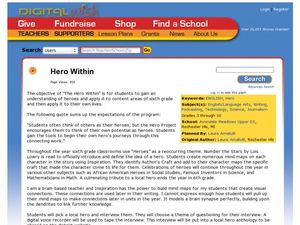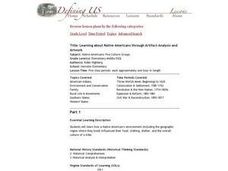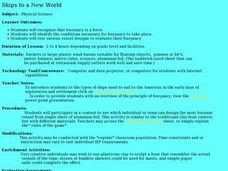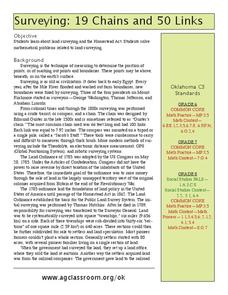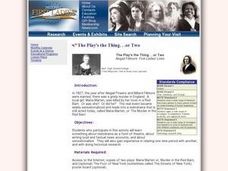Curated OER
Why Muscle Biology?
Learners research and define a muscle biology research question and organize an experiment to address the question utilizing either NADH staining or acid buffering. They analyze data as well as draw conclusions about their research....
Curated OER
Hero Within
Students interview a hero. In this heroes lesson plan, students read Number the Stars to begin a discussion about heroes and then create mind maps on each character. Students pick a local hero and interview them and then write a personal...
Curated OER
Design a Book Cover
Students explore character, plot, setting, symbolism, and conflict for a book that they are reading. Sample book covers are provided and students apply what they have learned by designing a book cover.
Curated OER
Lewis and Clark and Native Americans, Part II
Students research the Native Americans living in the regions explored by Lewis and Clark. They identify the modern-day names of sites claimed by the Lakota Indians, and create a poster of the original Native American names.
Curated OER
Marine Mammal Diving Reflex
Tenth graders discuss marine mammal diving reflex, and measure pulse rate while holding their breath under three conditions: control, warm water, and ice water to determine if humans exhibit marine mammal diving reflex.
Curated OER
Personal Resources
Students study taking care of themselves and their possessions. They develop a positive approach to life and a mature sense of self-worth and value. They discuss the importance of confidentiality in a class when sharing personal...
Curated OER
Learning about Native Americans through Artifact Analysis and Artwork
Sixth graders assess how a Native American's environment and the geographic region where they lived influenced their food, clothing, shelter and the overall culture of a tribe. They study the impact of conservation, family, rural life,...
Curated OER
Community Treasures (Rivers and Trees): An Integrated Curriculum Unit
Third graders demonstrate an understanding of geography and its effects on lifestyles and culture. Then they apply basic economic terms and principles
and identify the United States government and history. Students also identify and...
Curated OER
Ships to a New World
Students experiment with buoyancy as a force. In this buoyancy lesson, students access an assigned website to examine the sailing vessels that came to the New World. They work as teams to build boats out of aluminum foil to see which...
Curated OER
19 Chains and 50 Links
Students investigate surveys as it relates to chains and links. In this math lesson, students relate math to history and surveys done above, below and on the earths' surface. They review vocabulary pertaining to this lesson before moving...
PBS
Women's History: Clara Barton
Students investigate Clara Barton's contributions to society. In this Clara Barton lesson plan, students watch videos, listen to lectures, and conduct research regarding Clara Barton's life and her possible authorship of a Civil War...
Curated OER
Hershey and the World: The 5 Themes of Geography and Google Earth
Students invsestigate cocoa producing regions in the world. In this geography skills lesson, students examine how the 5 themes of geography affect the Hershey Chocolate Company as they compare and contrast cocoa production in America,...
Curated OER
France's New Medieval Castle Takes Shape
Learners explore how a dream to build a medieval castle came to reality. In this lesson, students read an article about a knight's castle that is being built in France, then complete numerous activities such as a quiz, a debate, a class...
Curated OER
Intermediate Sentence Completion 13
In this sentence completion worksheet, students complete the sentence by choosing the best words to complete them. Students complete 12 sentences.
Curated OER
Olympic Values
Students learn what it is to be an athlete in the Olympics. They focus on the motto of the Olympics and make their own classroom oath to complete the lesson.
National First Ladies' Library
The Play's the Thing...or Two
Students explore melodram as a form of theatre. They write about lucid and factual news accounts and about sensationalism. Students gain experience in relating one time period with another and with doing historical research.
Curated OER
Charts, Maps, and Graphs Lesson on the Holocaust
Young scholars practice interpreting data. In this Holocaust lesson, students research selected Internet sources and examine charts, maps, and graphs regarding the Jewish populations in and out of Europe. Young scholars respond to...
Curated OER
Confucius Say... China Old
Students locate China on the map. In this Chinese geography, history and culture lesson, students read literature about China. Students participate in paper making, silk making and lantern making activities.
Curated OER
Why People Trade
Students explore the role of government in the economy market. In this economics lesson, students analyze the decision making and how it takes into consideration additional cost, benefits and public awareness of what they are trying to...
Curated OER
Family Letter - Order of Operations and Sequences
For this order of operations and sequences worksheet, students solve 16 short answer problems. Students create an arithmetic sequence by adding seven to a number. Students perform operations on numbers in various order to see the...
Curated OER
Keystone Science School: Sustainable Automobiles
Students explore how to choose the correct car for them based on their needs.
Curated OER
Was There an Industial Revolution? Americans at Work Before the Civil War
Students tabulate the First Industrial Revolution where a significant number of inventions and innovations appeared transforming American life. Cite examples of change (ex. telegraph) in the lives of Americans during the era of question....
Curated OER
Kinesin and Exocytosis
Students design a visualization to illustrate the role of the protein kinesin in exocytosis of a secretory material in a directed manner.
Curated OER
Simple Spectroscope
Students make a spectroscope out of simple materials and are expected to view as many different light sources as possible to see the whole spectrum.

